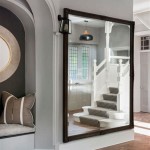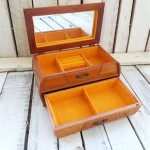```html
Art Nouveau Mirror Frames: A Reflection of an Era
Art Nouveau mirror frames represent a significant and beautiful element of the Art Nouveau movement, a style of art and design that flourished from the 1890s to the 1910s. Characterized by its organic forms, flowing lines, and a celebration of natural motifs, Art Nouveau aimed to break away from the rigid academic traditions of the 19th century. The movement sought to integrate art into everyday life, blurring the boundaries between fine art and decorative arts. Mirror frames, being both functional and decorative, became perfect canvases for Art Nouveau's distinctive aesthetic.
These mirror frames are more than mere holders of reflective glass; they are artistic statements that encapsulate the spirit of the age. They reflect the era's fascination with nature, its embrace of curvilinear forms, and its aspiration to create objects of beauty that elevated the mundane. The craftsmanship and materials employed in these frames further contributed to their artistic merit, making them highly sought-after collectibles and valuable indicators of the stylistic preferences of the period.
Key Characteristics: Organic Forms and Natural Motifs
One of the defining features of Art Nouveau mirror frames is the prevalence of organic forms and natural motifs. Inspired by the natural world, designers frequently incorporated elements such as flowers, plants, insects, and flowing water into their designs. These motifs were not merely decorative additions but were integral to the overall composition of the frame. The sinuous, asymmetrical lines, often referred to as "whiplash" curves, imitated the graceful movement of vines and tendrils, adding a sense of dynamism and fluidity to the frames.
Flowers, in particular, were a favored motif. Lilies, irises, orchids, and poppies were commonly depicted, each flower carrying symbolic meaning and adding layers of depth to the design. Irises, for instance, symbolized faith, hope, and wisdom, while lilies represented purity and beauty. The meticulous depiction of these floral elements, often with intricate details and vibrant colors, showcased the designers' deep appreciation for the beauty of nature.
Insects, such as dragonflies and butterflies, also found their place in Art Nouveau mirror frames. These delicate creatures, with their intricate wings and vibrant colors, were seen as symbols of transformation and renewal, aligning with the Art Nouveau's desire to break away from the past and embrace a new artistic vision. The use of these motifs added a touch of whimsy and elegance to the frames, making them captivating works of art.
The incorporation of flowing water or wave-like patterns further enhanced the organic feel of these frames. The sinuous curves and undulating forms simulated the movement of water, adding a sense of fluidity and grace to the design. This element contributed to the overall impression of harmony and balance, reflecting the Art Nouveau's aim to create objects that were both beautiful and functional.
Materials and Techniques: Craftsmanship and Innovation
Art Nouveau mirror frames were crafted from a variety of materials, each contributing to the overall aesthetic and quality of the piece. Wood, metal, glass, and ceramics were commonly employed, often in combination, to create intricate and visually stunning designs. The choice of materials and the techniques used to work with them showcased the craftsmanship and innovation of the era.
Wood, particularly hardwoods like mahogany and oak, was a popular choice for creating the structural framework of the frames. Skilled artisans carved intricate details into the wood, shaping it into flowing curves and replicating natural motifs. The use of wood allowed for a wide range of decorative possibilities, from delicate floral carvings to bold, sculptural forms. Furthermore, different wood finishes, such as staining and varnishing, were applied to enhance the natural beauty of the wood grain and to protect the frame from damage.
Metal, including bronze, copper, and iron, was often used to create elaborate overlays and decorative accents. Metalworkers employed techniques such as repoussé, chasing, and etching to create intricate designs that complemented the wooden framework. The use of metal added a touch of elegance and sophistication to the frames, enhancing their overall visual appeal. Bronze, in particular, was favored for its durability and its ability to be molded into complex shapes.
Glass played a crucial role in Art Nouveau mirror frames, not just as the reflective surface but also as a decorative element. Stained glass or beveled glass panels were sometimes incorporated into the frames, adding color and texture to the design. The use of these specialized glass techniques enhanced the overall artistic effect, transforming the frames into miniature works of art. Furthermore, the reflective surface of the mirror itself was often treated with special techniques, such as silvering or etching, to create unique visual effects.
Ceramics, particularly glazed tiles or ceramic inlays, were occasionally used to add color and texture to Art Nouveau mirror frames. Ceramic tiles, often adorned with floral or geometric patterns, were carefully placed within the wooden framework, creating a mosaic-like effect. The use of ceramics added a tactile dimension to the frames, inviting viewers to appreciate the craftsmanship and attention to detail.
Notable Designers and Examples
Several designers and artists made significant contributions to the development of Art Nouveau mirror frames. Their innovative designs and meticulous craftsmanship helped to define the aesthetic of the period and to elevate mirror frames to the status of art objects. Examining the works of these influential figures provides valuable insights into the stylistic trends and artistic sensibilities of the Art Nouveau movement.
Émile Gallé, a French artist and designer, was renowned for his innovative use of glass and his integration of natural motifs into his designs. While primarily known for his glasswork, Gallé also created stunning mirror frames that showcased his mastery of the Art Nouveau aesthetic. His frames often featured intricate floral carvings and delicate glass inlays, reflecting his deep appreciation for the beauty of nature. Gallé's work exemplified the Art Nouveau's desire to blur the boundaries between art and craft, creating objects that were both functional and visually stunning.
Louis Comfort Tiffany, an American artist and designer, was celebrated for his innovative use of glass and his creation of iridescent surfaces. Tiffany's stained glass windows and lamps are iconic examples of Art Nouveau design, and his mirror frames were equally impressive. His frames often featured iridescent glass panels and intricate metalwork, creating a shimmering effect that captivated viewers. Tiffany's work reflected the Art Nouveau's fascination with light and color, transforming ordinary objects into extraordinary works of art.
Other notable designers who contributed to the Art Nouveau mirror frame tradition include Hector Guimard, Victor Horta, and Eugène Vallin. These artists, each with their unique style and approach, helped to shape the aesthetic of the period and to create a diverse range of beautiful and functional mirror frames. Their works continue to inspire and to influence contemporary design, demonstrating the enduring legacy of the Art Nouveau movement.
Examples of Art Nouveau mirror frames can be found in museums, private collections, and antique shops around the world. These frames vary in size, shape, and design, reflecting the diversity of the Art Nouveau movement. Some frames are simple and elegant, with delicate floral carvings and flowing lines, while others are elaborate and ornate, with intricate metalwork and vibrant glass inlays. Each frame tells a story about the era in which it was created, offering a glimpse into the artistic sensibilities and cultural values of the Art Nouveau period.
The enduring appeal of Art Nouveau mirror frames lies in their beauty, craftsmanship, and historical significance. These frames are not just objects of decoration but also reflections of an era, encapsulating the spirit of innovation, creativity, and appreciation for nature that defined the Art Nouveau movement. Their intricate designs, high-quality materials, and meticulous craftsmanship make them highly sought-after collectibles and valuable reminders of a bygone era.
```
Vintage Art Nouveau Gold Mirror Furniture Deco

The Jewelry Lady S Art Nouveau Mirror Furniture Design
Bonhams The First Cuckoo A Wmf Art Nouveau Mirror Frame

Fabulous Wall Mirror Frame In Art Nouveau Style With Lilies For At 1stdibs Mirrors Fabulouswall

Art Nouveau Iris Frame Patinated Metal And Mirror Europe Early 20th Century Rectangular With A Decorative Openwork Frames Crafts

Sold At Auction Art Nouveau Mirror German Around 1900 Frame Beech With

French Art Nouveau Mirror Ammi Ribar Antiques Fine Period Frames

Art Deco Furniture Foter Nouveau Interior Design

6 5 Vintage Art Nouveau Mirror Brass Frame Lady Of The Lake Antique

Art Nouveau Architectural Mirror Frame With Lilies Floral Pierced Trim Norway








